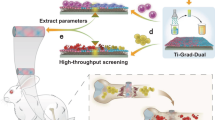Abstract
Commercially pure titanium (cp-Ti) is widely used in the field of long-term clinical oral implantology owing to its ability to allow close bone-implant apposition. The optimization of its function based on artificial proteins has become a key issue in the development of improved cp-Ti implants. Here, we set out to identify peptide aptamers with preferential adsorption towards titanium-based implants through the phage display methodology. Fifteen sequences were selected in the third round of biopanning. One sequence, ATWVSPY (named TBP1), had a 40% repetition rate and exhibited the strongest binding affinity to cp-Ti disks. Ten sequences were selected in the fourth round, among which the repetition rate is 80% for TBP1 and 20% for TBP2 (GVGLPHT). The peptide aptamers against cp-Ti disks can provide an alternative method of functional coating for biomaterial surfaces.




Similar content being viewed by others
References
Kashiwagi K, Tsuji T, Shiba K. Directional BMP-2 for functionalization of titanium surfaces. Biomaterials. 2009;30:1166–75. doi:10.1016/j.biomaterials.2008.10.040.
Le Guehennec L, Soueidan A, Layrolle P, Amouriq Y. Surface treatments of titanium dental implants for rapid osseointegration. Dent Mater. 2007;23:844–54. doi:10.1016/j.dental.2006.06.025.
Schuler M, Trentin D, Textor M, Tosatti SG. Biomedical interfaces: titanium surface technology for implants and cell carriers. Nanomed. 2006;1:449–63. doi:10.2217/17435889.1.4.449.
Nakamura HK, Butz F, Saruwatari L, Ogawa T. A role for proteoglycans in mineralized tissue-titanium adhesion. J Dent Res. 2007;86:147–52. doi:10.1177/154405910708600208.
Schliephake H, Scharnweber D. Chemical and biological functionalization of titanium for dental implants. J Mater Chem. 2008;18:2404–14. doi:10.1039/b715355b.
Kroese-Deutman HC, Van Den Dolder J, Spauwen PHM. Influence of RGD-loaded titanium implants on bone formation in vivo. Tissue Eng. 2005;11:1867–75. doi:10.1089/ten.2005.11.1867.
Fujisawa R, Mizumo M, Nodasaka Y, Kuboki Y. Attachment of osteoblastic cells to hydroxyapatite crystals by a synthetic peptide (Glu7-Pro-Arg-Asp-Thr) containing two functional sequences of bone sialoprotein. Matrix Biol. 1997;16:21–8.
Sawyer AA, Hennessy KM, Bellis SL. The effect of adsorbed serum proteins, RGD and proteoglycan-binding peptides on the adhesion of mesenchymal stem cells to hydroxyapatite. Biomaterials. 2007;28:383–92. doi:10.1016/j.biomaterials.2006.08.031.
Gronewold TM, Baumgartner A, Weckmann A, Knekties J, Egler C. Selection process generating peptide aptamers and analysis of their binding to the TiO2 surface of a surface acoustic wave sensor. Acta Biomater. 2009;5:794–800. doi:10.1016/j.actbio.2008.09.014.
Matsui T, Matsukawa N, Iwahori K, Sano K, Shiba K, Yamashita I. Realizing a two-dimensional ordered array of ferritin molecules directly on a solid surface utilizing carbonaceous materials affinity peptides. Langmuir. 2007;23:1615–8. doi:10.1021/la061318t.
Sano K, Shiba K. A hexapeptide motif that binds to the surface of titanium. J Am Chem Soc. 2003;125:14234–5. doi:10.1021/ja038414q.
Oya K, Tanaka Y, Saito H, Kurashima K, Nogi K, Tsutsumi H, et al. Calcification by MC3T3–E1 cells on RGD peptide immobilized on titanium through electrodeposited PEG. Biomaterials. 2009;30:1281–6. doi:10.1016/j.biomaterials.2008.11.030.
Segvich SJ, Smith HC, Kohn DH. The adsorption of preferential binding peptides to apatite-based materials. Biomaterials. 2009;30:1287–98. doi:10.1016/j.biomaterials.2008.11.008.
Gungormus M, Fong H, Kim IW, Evans JS, Tamerler C, Sarikaya M. Regulation of in vitro calcium phosphate mineralization by combinatorial selected hydroxyapatite-binding peptides. Biomacromolecules. 2008;9:966–73. doi:10.1021/bm701037X..
Sarikaya M, Tamerler C, Jen AY, Schulten K, Baneyx F. Molecular biomimetics: nanotechnology through biology. Nat Mater. 2003;2:577–85. doi:10.1038/nmat964.
Sarikaya M, Tamerler C, Schwartz DT, Baneyx F. Materials assembly and formation using engineered polypeptides. Ann Rev Mater Res. 2004;34:373–408. doi:10.1146/annurev.matsci.34.040203.121025.
Brown S, Sarikaya M, Johnson E. Genetic analysis of crystal growth. J Mol Biol. 2000;299:725–32. doi:10.1006/jmbi.2000.3682.
Donatan S, Yazici H, Bermek H, Sarikaya M, Tamerler C, Urgen M. Physical elution in phage display selection of inorganic-binding peptides. Mater Sci Eng C. 2009;29:14–9. doi:10.1016/j.msec.2008.05.003.
Thai CK, Dai HX, Sastry MSR, Sarikaya M, Schwartz DT, Baneyx F. Identification and characterization of Cu2O- and ZnO binding polypeptides by E. coli cell surface display: toward an understanding of metal oxide binding. Biotechnol Bioeng. 2004;87:129–37. doi:10.1002/bit.20149.
Hsu SH, Liu BS, Lin WH, Chiang HC, Huang SC, Cheng SS. Characterization and biocompatibility of a titanium dental implant with a laser irradiated and dual-acid etched surface. Bio-Med Mater Eng. 2007;17:53–68.
Kawahara H, Mimura Y, Oki M. In vitro study on cell adhesive strength to titanium with anodic oxidation and nitridation. In: Kawahara H, editor. Oral implantolody and biomaterials. Amsterdam: Elsevier Science Publishers BV; 1989. p. 169–76.
Mante M, Daniels B, Golden E, Diefenderfer D, Reilly G, Leboy PS. Attachment of human marrow stromal cells to titanium surfaces. J Oral Implantol. 2003;29:66–72. doi:10.1563/1548-1336(2003)029<0066:AOHMSC>2.3.CO;2.
Mante FK, Little K, Mante MO, Rawle C, Baran GR. Oxidation of titanium, RGD peptide attachment, and matrix mineralization rat bone marrow stromal cells. J Oral Implantol. 2004;30:343–9.
Acknowledgments
This research was funded by National Science Foundation of China which was conferred to Dr.B.Zhou (NSFC No.30700957). The authors are grateful to the Analytical and Testing Center, Huazhong University of Science and Technology in China for technical assistance.
Author information
Authors and Affiliations
Corresponding author
Rights and permissions
About this article
Cite this article
Liu, Y., Mao, J., Zhou, B. et al. Peptide aptamers against titanium-based implants identified through phage display. J Mater Sci: Mater Med 21, 1103–1107 (2010). https://doi.org/10.1007/s10856-009-3970-3
Received:
Accepted:
Published:
Issue Date:
DOI: https://doi.org/10.1007/s10856-009-3970-3




